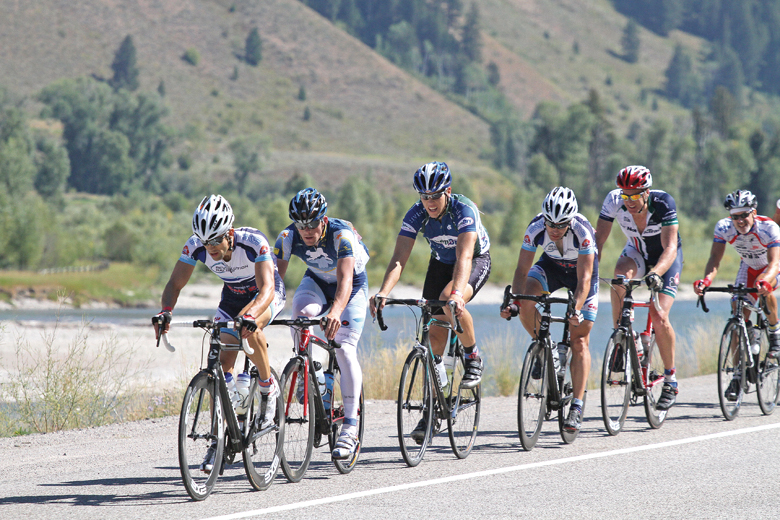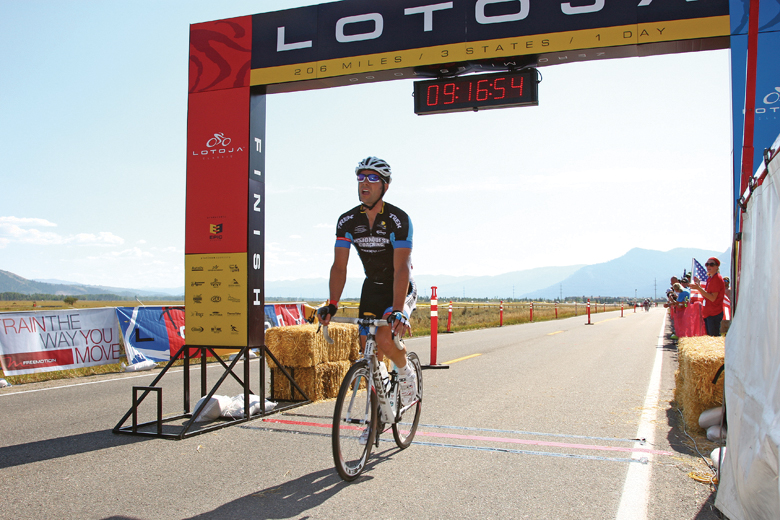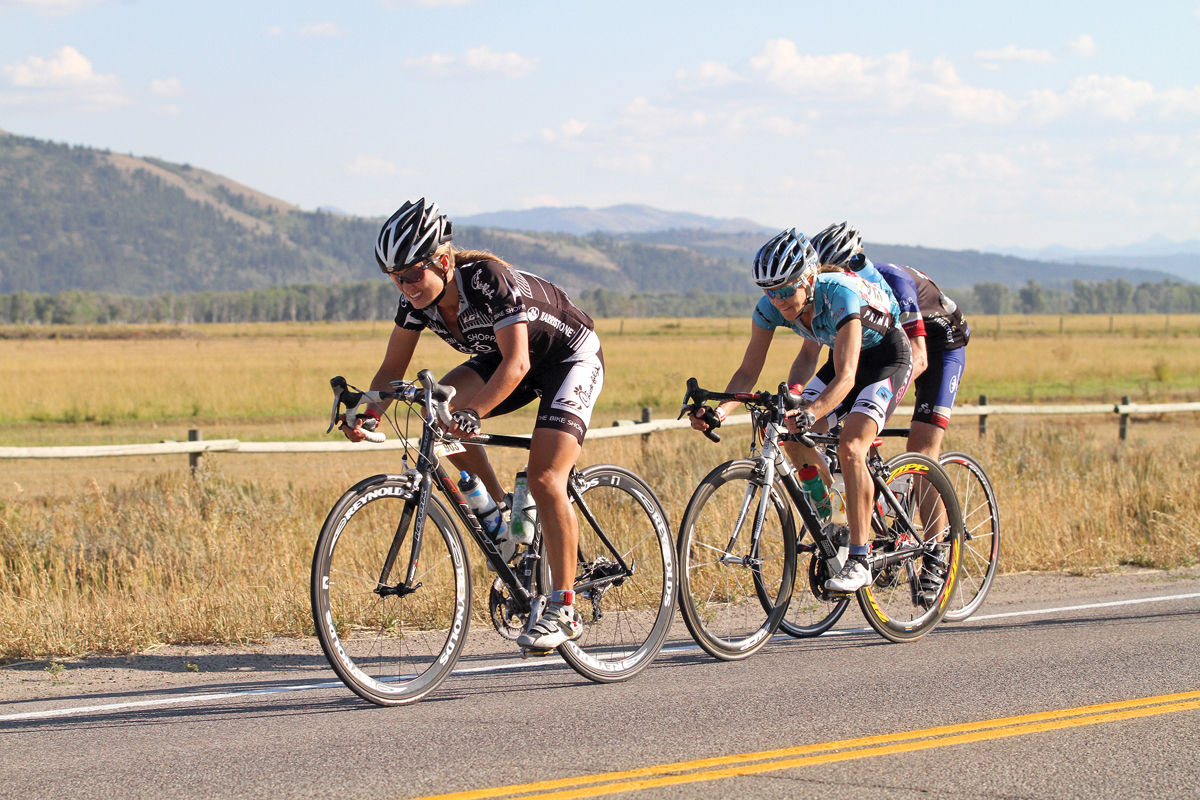By David Bern –
For Clinton Mortley of Albuquerque, NM, this year’s 29th Annual LoToJa Classic was the “weirdest” race he’s ever ridden. It’s also the biggest— and the only race so far—he’s won.
That puzzling feeling began with only five miles under the wheels as Mortley (Team Kelson) and the Men’s I, II, III field headed north on Logan’s 10th West before dawn on Sept. 10.

“Mark Schaefer (Barry Lasko/Paul Tracy Racing) rolled off the front and nobody chased him,” he said. “It was dark and he just disappeared up the road. I couldn’t see him. Everybody knows how strong Schaefer is. But they just let him go. I knew it right there it was going to be a weird race.”
Schaefer, who has placed highly in several LoToJa’s, impressively stayed clear for over 125 miles before getting caught—and still ended the day in fifth place out of the 46-rider field. But he wasn’t the only one the peloton let disappear out of sight. Mortley too spent considerable time alone on the 206-mile course before taking the win in an exciting six-man sprint at Jackson Hole Mountain Resort. His winning time was 9:16:36.

“After I crossed the finish line, I just couldn’t believe I did it,” said the 24-year-old who is an accounting major at Brigham Young University Idaho at Rexburg. “I had worked so hard to win this year’s LoToJa… Now what am I going to do with the rest of my life!”
Another rider who also worked hard this season and couldn’t believe she won was Keri Gibson (The Bike Shoppe/Chick-Fil-A) of Pleasant View, Utah. The 36-year-old mother of three showed strength and determination throughout the day to win the Women’s I, II, III category in a sprint over Lisa Renee Tumminello (Primal Treads). Gibson clocked in at 10:13:41.

For her the victory was particularly sweet. Not only had she trained hard and raced as much as she could since 2010 to prepare for this year’s LoToJa, her husband, Justin, also won the Men’s Cat. III, IV race in 9:35:02. To make things even sweeter, the winning pair celebrated their 18th wedding anniversary on race day.
“It was very emotional for me,” she said about winning. “To see all that training and hard work pay off was very rewarding. It really meant a lot. And it was awesome my husband was there at the finish line. He was just as surprised as I was that I won, and it was neat that he had won his race, too.”
Surprise tended to rule the day. One that was especially welcomed was the balmy morning temperature of 54 degrees Fahrenheit as over 1,500 riders left Sunrise Cyclery in timed intervals. Typically, the morning start is 10 to 15 degrees cooler. Clinton Mortley noted the warm, pre-dawn morning air. But his thoughts were focused on the pack’s continued reluctance to chase down Mark Schaefer’s bold escape.
While the Men’s I, II, III field neared Preston, a 10-man break formed and Mortley quickly joined in. But it was caught just before Preston and the bunch stayed together through feed zone #1 and the initial rollers in Strawberry Canyon. By then, Schaefer was more than five minutes up the road.
While Mortley contemplated making a jump, Darren Goff (The Bike Shoppe/Chick-Fil-A) beat him to it before the pack reached Mink Creek. Mortley again was surprised that no one chased. At that point he concluded the day wasn’t going to happen as he originally thought: the pack would stay together and then finally detonate on Salt River Pass. With Schaefer and now Goff up the road, the day’s final selection wouldn’t happen on the last major climb.
“Less than a minute after Goff went, I took off,” said Mortley. “It was just instinct. I knew that I could put out a high tempo, get caught, and still race if I had to. So I went for it.”
He chased after Goff to the canyon’s 7,424 foot-high summit, down into Ovid and onto the second feed zone in Montpelier. While climbing to 6,923 foot-high Geneva Summit, and Goff not yet in sight, Mortley began to think he was stuck in no man’s land.
“I started to think I had tossed my race away,” he said. “I knew that I had seven minutes on the pack, but I had no idea how far ahead Schaefer or Goff were.”
But while descending from Geneva Summit, he finally saw Goff and caught him near the intersection of Highways 61 and 89. The two rode tempo to the base of Salt River Pass, hoping they’d eventually bridge to Schaefer.
“We survived going up Salt River. We didn’t attack each other. I was cramping and suffering,” said Mortley. “We knew that Schaefer was up to four minutes ahead as we climbed.”
The pair crested Salt River’s 7,630 foot-high summit and began the descent into Star Valley. Just before Afton, they were caught by a five-man chase group that consisted of Justin Wilson (Revolution/Café Rio), Curtis Doman (Revolution/Café Rio), Andrew Neilson (Nordic Track/Logan Race Club), Stefan Gomez (New Hope 360/Trek/GS Boulder), and last year’s Cat. Men’s I, II, III winner, Garrett Burbidge (Ski Utah/MarketStar).
After the feed zone at Afton, “We threw the hammer down,” said Mortley. “We were just hauling and I was hurting. We caught Schaefer in about 20 minutes. When we passed him, he was like toast.”
Mortley noted that Schaefer grabbed a wheel and stayed at the back to rest—but not for long. Soon, the day’s big escapee amazingly began taking turns at the front. As the seven-man break neared Alpine Junction, Burbidge punctured but got a quick wheel change and rejoined the group at Alpine. “He was cooked from the chase,” said Mortley. “But he caught us. I was impressed.”
Not wanting to get caught by the peloton, the riders worked hard tempo up Snake River Canyon to Hoback Junction. Meantime, behind them Sam Krieg (Ski Utah/MarketStar) was attempting to bridge.
“No one attacked in the canyon. I felt terrible and I think everyone else did, too,” said Mortley. “And no one attacked on the final climb after the river (five miles north of Hoback Junction). I think everyone was toast. At that point, I knew it was going to come down to a sprint finish.”
The break stayed together on South Loop Road, the bike path, through the bike tunnel and the Wilson/Village Road intersection. Even on the final seven-mile run in to the finish, no one made a jump—until about a half mile to go.
“At that point we slowed down to about 15 miles per hour and everyone started to play the ‘check game,’” said Mortley. “And then Gomez took off first.”
As Gomez made a break for the line, Doman and Schaefer reacted. “But it was half-hearted because they knew Gomez wouldn’t last, and they didn’t want to blow the sprint,” noted Mortley. While the finish line neared, he stayed in the back and the group caught Doman and Schaefer.
But Doman wasn’t done. He jumped again, and this time, Wilson and Mortley joined him. The three passed Gomez with less than 500 meters to the line.
“Doman and Wilson threw it down hard,” said Mortley. “I felt like I had a sprint left. Instinct just took over and I went for it.” He beat Wilson at the line by half a bike length with Doman right behind.
After the finish, Mortley was ecstatic about his achievement. In less than 18 months, he had gone from a Cat. IV who got routinely dropped at crits and road races, to a Cat. III who won the top men’s race at the 2011 LoToJa Classic.
Late last year, he took second place in the Cat. IV race at the Allen Butler Criterium in Idaho Falls, ID. He followed that success with another second place in last year’s LoToJa Cat. IV race. He finished that day with a time of 9:05:22. The criterium and strong LoToJa finish made him realize that, “I could be a good bicycle racer.”
The realization also motivated him to work harder and get faster. “After last year’s LoToJa, I wanted to win the Cat. I race in 2011,” he said. “ I made it a goal because the glory is in the Cat. I race. I’m happy that I achieved it.”
He added that being an “unknown” likely helped a lot in his initial escape in Strawberry Canyon, and during the sprint finish. The night before the race, he knew that he had trained and raced hard over the summer. He was confident in his abilities, yet at the same time, he wondered if he could keep up when the pace switched from tempo to flat out for several miles. His result proved that he could.
Cat. I, II, III Women’s winner Keri Gibson shared similar thoughts before she pulled up to the start line.
“The night before I began to wonder if I had trained enough,” she said. “I went into the race wanting to do better than I had before, but I didn’t think I had a chance of winning it. My goal was just to improve from the previous year. To podium would be a bonus.”
The Women’s Cat. I, II, II and Women’s Cat. IV riders left Sunrise Cyclery together. As the 32-member field worked its way toward Preston, no one saw fit to take a flyer. But during a neutral bio break in Strawberry Canyon, a couple of riders got off the front. For Gibson, that’s when the race really began.
“We began chasing after who was off the front,” she said. The “who” actually turned out to be more than one. Kit Deslauriers (Hoback Sports) and a few others were making their way to Strawberry Summit when they were caught and dropped by a six-woman break of Gibson, Lisa Renee Tumminello, Kandice Lund (Bountiful Mazda/Bountiful Bicycle), Beth McMaster (Bountiful Mazda/Bountiful Bicycle) plus Revolution/Café Rio teammates Megan Hill and Anne Perry or Catherine Kim.
Gibson said the break stayed together on the descent to Ovid and into the feed zone at Montpelier. But after the feed only Tumminello, McMaster, Lund and Gibson began the Geneva Summit climb. Together they descended and crossed the state line into Wyoming. But once they started climbing Salt River Pass, only Gibson had wings.
“I dropped all three on the way up. I wasn’t really trying to—I thought they were behind me,” she said. With the gap, she flew down from the summit into Star Valley. She wasn’t seen again until Thayne when Tumminello, McMaster and Lund finally caught her.
“I turned around and they pulled up,” said Gibson. “One side of me was relieved because there was a headwind and I doubted I could do it alone. The other side of me said, ‘Darn.’”
The four rode through Thayne, Alpine Junction and far into Snake River Canyon without anyone attempting to jump. After the neutral feed zone at Hoback Junction, it was just Gibson and Tumminello riding the last 30 miles toward the finish line.
“We worked well together the rest of the way until 3K to go,” said Gibson. “At the 2K sign I jumped to accelerate and Lisa stayed on my wheel. After 1K I gave it all I had to the finish line. At 100 meters I started to sprint and won!”
After being congratulated by her husband at the finish, it still hadn’t sunk in that she had won. But when the results were officially posted, she knew then that it was “real.”
A month after her victory, Gibson wrote the following when asked if winning this year’s race had changed her.
“That is a hard answer to put into words. …It was a very emotional finish and humbling experience. I honestly didn’t think I would see first place in the Cat. 1-3 division. This victory helped me realize not to underestimate myself and my abilities. It was a testament that hard work and dedication does pay off. At the finish, and the day after, I was so grateful to my family for all the support they gave to me throughout the season and during the race. You can’t complete LoToJa without an awesome support crew! It is every bit of their victory as it is mine.”
Both Gibson and Mortley say they intend to defend their LoToJa titles next September.
And Race Director Brent Chambers says LoToJa will be there for them and 1,500-plus riders who want to challenge themselves on the 206-mile course—a course, which for him and many participants, is a “metaphor for life.” Chambers says his biggest joy is hearing how LoToJa has changed someone’s life for the better. The event challenges and inspires people to live healthier lives, and that is his biggest reward. It encourages him to keep making the event better and safer with each year.
The race director stressed that LoToJa would not be possible without the event’s loyal corps of volunteers and sponsors, nor without the working partnerships and support from all of the communities the race passes through every year.
2011 LoToJa factoids:
- The fastest time of the day was posted in the licensed men’s 35-44 master’s division by Michael Olsen (Red Burro Racing) at 9:13:37.
- Finish rate percentages:
- Licensed Class = 89%
- Citizen Class = 84%
- Fun Ride Class = 86%
- The oldest rider to finish LoToJa was 74 years old
- The youngest rider to finish LoToJa was 13 years old
- The average participant age is 41
- This year cyclists came from 40 states, plus Canada and the United Kingdom
- It’s estimated the average racing cyclist burns 10,000 to 15,000 calories during race day
- Since LoToJa’s first year in 1983, more than 2.7 million miles have been pedaled by cyclists racing the event.
- Over 450 course and neutral support volunteers were on hand
Course Records:
- Men’s Record: Alfred Thresher, Las Vegas, NV at 9:01:44 (2010) – (Previous record was set in 2009 by Cameron Hoffman, Clearfield, UT at 9:02:52)
- Women’s Record: Jenn Halladay, Kuna, ID at 9:44:57 (2010) – (Previous record was set in 2006 by Tiffany Mainor, Las Vegas, NV at 9:55:06)
King/Queen of Mountain Records (4 mile climb at 8 to 9 percent grade):
- Men’s: David Francis, Las Vegas, NV – 13:35.70 (2008)
- Women’s: Tayler Wiles, Bluffdale, UT – 16:52.93 (2009)
Fund raising facts
- This year the Huntsman Cancer Foundation will receive over $175,000 from LoToJa’s fund-raising efforts
- LoToJa’s 75 Huntsman Hometown Heroes raised over $120,000 alone
- Huntsman Cancer’s mission is to understand cancer from its beginnings, to use that knowledge in the creation and improvement of cancer treatments, to relieve the suffering of cancer patients, and to educate the public about cancer risk, prevention, and care.
- LoToJa also raises money for Autism Spectrum Disorder Connections (or ASD Connections). ASD Connections is a non-profit organization focused on helping families of children with autism. ASDC offers a range of services from a one-time consultation on a specific issue, to tutoring and therapy sessions several times a week.





